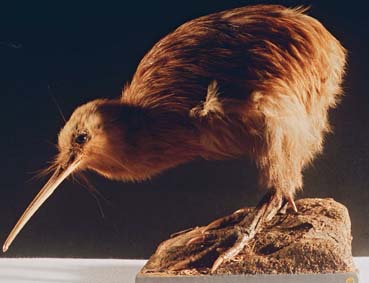
|
Some of the specimens in our Collections - like the kiwis and tuatara from New Zealand and the monotremes and marsupials from Australia - are of endangered species.
These rare specimens were obtained many years ago before it
became evident that collecting would contribute to the rapid decline
in species that has occurred recently. But even then the Curators were aware that care
had to be taken and they obtained our specimens from reputable museums
that had a specimen to spare, or from zoological gardens, when animals
died, or when naturalists found dead animals in the wild.
|
 Conservation, New Zealand. Photo: J. Kendrick |
 Conservation, New Zealand |
In 1991, the Department of Conservation (DOC) in New Zealand launched the
Kiwi Recovery Programme to save the kiwi from extinction. This programme
shows the ingenuity, dedication and effort that is needed to protect
and expand species at threat.
The Kiwi Recovery Programme involves:
Looking after kiwis in the wild by:
- Nation-wide surveys to monitor kiwi populations;
- Protecting nests from predators;
- Managing key populations to save genetic diversity;
- Establishing the endangered Little Spotted Kiwi on offshore island sanctuaries.
- Educational programmes;
- Seeking help from the community.
- The threats facing the kiwi and what must be done to save them
- Kiwi genetics, breeding and habitat requirements.
Raising chicks in Captivity - Operation Nest Egg:
Without help, most kiwi chicks are killed by stoats or cats in the wild. Operation Nest Egg was a major breakthrough in finding ways to save the kiwi. This technique enables eggs taken from the wild to be hatched in captivity, so that young birds can be put back into the forest when they are big enough to survive.
Young Tuatara. Copyright: The Department of Conservation, New Zealand. Photo: D. Newman |
Learn more about New Zealand's unique animals and plants and the work of the Department of Conservation, the Kiwi recovery Programmes and the efforts to save other endangered species like the Tuatara, Royal Albatross, Kakapo and Takahe by visiting the DOC website.
We are grateful to the Department of Conservation, New Zealand for permission to use their photographs of kiwis, tuataras and Royal Albatrosses in the wild to illustrate our Collections web-site.










